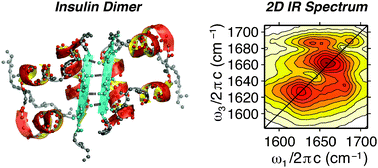Insulin dimer dissociation and unfolding revealed by amide I two-dimensional infrared spectroscopy†
Abstract
The monomer–dimer transition of

- This article is part of the themed collection: Biomolecular Structures
* Corresponding authors
a
Department of Chemistry, Massachusetts Institute of Technology, 77 Massachusetts Avenue, Cambridge, USA
E-mail:
tokmakof@mit.edu
Fax: +1 617 2537030
Tel: +1 617 2534503
The monomer–dimer transition of

 Please wait while we load your content...
Something went wrong. Try again?
Please wait while we load your content...
Something went wrong. Try again?
Z. Ganim, K. C. Jones and A. Tokmakoff, Phys. Chem. Chem. Phys., 2010, 12, 3579 DOI: 10.1039/B923515A
To request permission to reproduce material from this article, please go to the Copyright Clearance Center request page.
If you are an author contributing to an RSC publication, you do not need to request permission provided correct acknowledgement is given.
If you are the author of this article, you do not need to request permission to reproduce figures and diagrams provided correct acknowledgement is given. If you want to reproduce the whole article in a third-party publication (excluding your thesis/dissertation for which permission is not required) please go to the Copyright Clearance Center request page.
Read more about how to correctly acknowledge RSC content.
 Fetching data from CrossRef.
Fetching data from CrossRef.
This may take some time to load.
Loading related content
